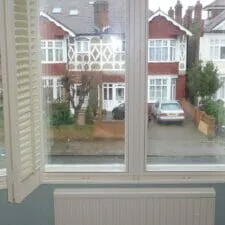
Condensation is a very common problem that affects millions of homes throughout the UK. If you have noticed water droplets streaming down the inside of your windows, it is important to take control of the situation ASAP.
Here at City Sound Glazing, we can help homeowners like you put an end to their condensation problems before they escalate into a nightmare. In the meantime, the following information should prove to be useful.
What is condensation?
You already know what condensation looks like, especially if it is a daily occurrence in your bathroom, bedroom, kitchen, or lounge. It is the most common type of damp found in UK homes and can quickly contribute to the development of mould. Given the plethora of health problems caused by mould, you must not leave the issue untreated. But what actually is condensation?
Condensation is when water moisture in the air transforms from a gas state to a liquid state. When warm air comes into contact with cold surfaces, it cannot hold the water vapour. So, as the hotter air rises, the moisture is left behind and causes the droplets to form.
Windows are generally less insulated than walls, meaning that they are the coldest part of the room, which is why condensation is most likely to develop there. Both single-glazed and double-glazed windows are vulnerable to this issue.
Your home could potentially encounter several forms of condensation, including;
- Warm-front condensation when warm air enters cold environments.
- Surface condensation when water droplets form on window glass.
- Reverse condensation and cold bridge condensation, which form on the walls.
Condensation is most likely to surface in the winter months as the difference in temperature between the warm air from your heating systems and cold air from the outside are at their greatest. In most cases, condensation will form on the windows before it hits the walls. So, if you notice moisture forming on the windows, overcoming the problem today could save a lot of hassle in the long run.

How to stop condensation in your home
Condensation is primarily attributed to two main issues; humidity and ventilation.
Experts suggest that optimal humidity levels should be 40-60% in the summer and 30-50% in the winter. Meanwhile, poor ventilation can make it very difficult to manage the moisture levels within your home. Several simple steps can be implemented to help prevent the two main issues that cause condensation, such as;
- Invest in a dehumidifier to collect moisture from the air within your home.
- Ensure that windows are opened at least some of the time (even in winter) to enable ventilation throughout the property.
- Keep the heating on a lower setting.
- Use your exhaust fan regularly to ensure that moisture exits the building.
- Open your drapes or blinds during the daytime to prevent moisture from getting trapped between them and the windows.
These steps can help minimise the presence of condensation and help slow the accumulation of water droplets on your windows. For the best results, though, you need to treat the source of your problems too.
Combat condensation with secondary glazing

One of (if not the) best ways to reduce condensation is to install secondary glazing. Secondary glazing is great for thermal insulation, which can help with some of the other issues like running your heating systems at a lower temperature. More importantly, it actively reduces the development of condensation on both the primary and secondary windows.
This is because secondary glazing creates a tight internal seal that enables a low level of ventilation within the window reveal cavity. This ultimately stops the inner glass from becoming too cold, which can stop water droplets from forming on the windows in an effective way. Better still, it is a move that can provide a permanent solution, which also translates to exceptional value.
They are suitable for unsealed primary windows or trickle vents, ensuring that you still retain heat insulation without trapping any moisture to the primary window. Given that the average home produces 24 pints of moisture daily, this combination of ventilation without losing comfort is essential.
With the right solution in place, you can expect to see a significant reduction in condensation throughout the home while many customers eradicate the problem altogether. Secondary glazing can be used in a single room that is causing problems or throughout the entire property.
However, you will only see the benefits of secondary glazing for condensation control when they are high-quality solutions that have been fitted by an expert.
For the best secondary glazing in London and the surrounding areas, contact us at City Sound Glazing to arrange a full consultation today.

